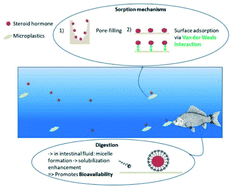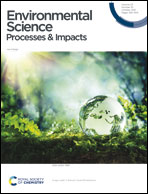Adsorption of progesterone onto microplastics and its desorption in simulated gastric and intestinal fluids†
Abstract
The sorption of hydrophobic organic compounds (HOC) onto microplastics is relatively well reported in the literature, while their desorption remains poorly investigated, especially in biological fluids. The present study investigated the sorption and desorption of progesterone on polyethylene (PE), polypropylene (PP), and polystyrene (PS) microplastics. The sorption experiments showed that the equilibrium was reached in a few hours for all plastics. A sorption efficiency of 357.1 μg g−1 was found for PE and PS, and 322.6 μg g−1 for PP. Sorption experiments indicated that adsorption would certainly happen via surface sorption and a potentially pore-filling mechanism. The desorption was carried out in Simulated Gastric Fluid (SGF) and Simulated Intestinal Fluid (SIF), whose formulations were more complex than similar models reported so far. It has been found that the desorption was higher in SIF as compared to SGF, due to micelle formation in SIF promoting the pollutant solubilization. The sorption of pepsin onto microplastics has also been revealed, suggesting a competition between pollutants and pepsin for sorption sites and a potent reduction in pollutant solubilization. This study indicates that the ingestion of microplastics could be considered as an additional route of exposure to pollutants and therefore emphasizes pollutant bioavailability for aquatic organisms.

- This article is part of the themed collections: SDG14: Life Below Water – Marine Litter (Plastics and Pollution) and Best Papers 2021 - Environmental Science: Processes & Impacts


 Please wait while we load your content...
Please wait while we load your content...